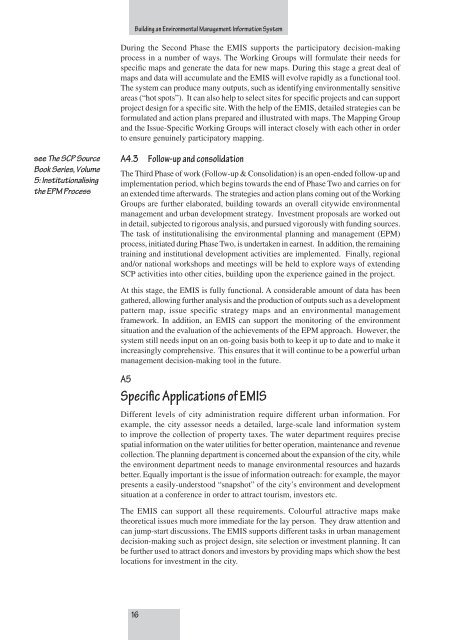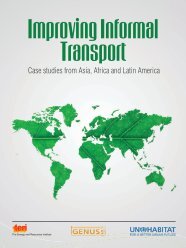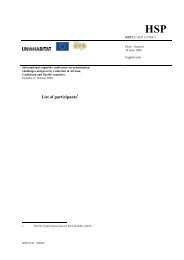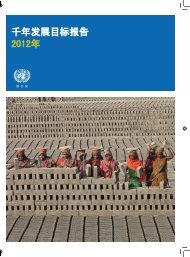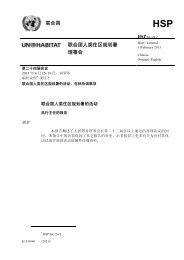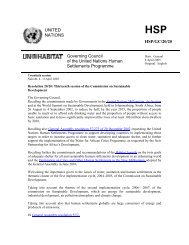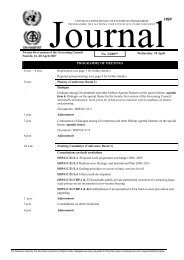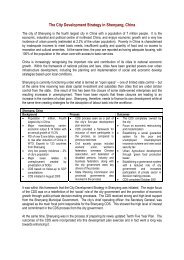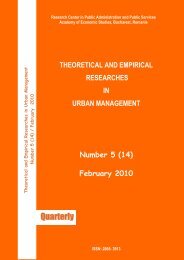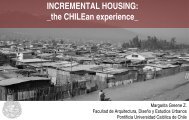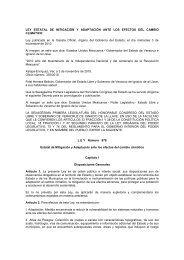EMIS - UN-Habitat
EMIS - UN-Habitat
EMIS - UN-Habitat
You also want an ePaper? Increase the reach of your titles
YUMPU automatically turns print PDFs into web optimized ePapers that Google loves.
see The SCP Source<br />
Book Series, Volume<br />
5: Institutionalising<br />
the EPM Process<br />
Building an Environmental Management Information System<br />
During the Second Phase the <strong>EMIS</strong> supports the participatory decision-making<br />
process in a number of ways. The Working Groups will formulate their needs for<br />
specific maps and generate the data for new maps. During this stage a great deal of<br />
maps and data will accumulate and the <strong>EMIS</strong> will evolve rapidly as a functional tool.<br />
The system can produce many outputs, such as identifying environmentally sensitive<br />
areas (“hot spots”). It can also help to select sites for specific projects and can support<br />
project design for a specific site. With the help of the <strong>EMIS</strong>, detailed strategies can be<br />
formulated and action plans prepared and illustrated with maps. The Mapping Group<br />
and the Issue-Specific Working Groups will interact closely with each other in order<br />
to ensure genuinely participatory mapping.<br />
A4.3 Follow-up and consolidation<br />
The Third Phase of work (Follow-up & Consolidation) is an open-ended follow-up and<br />
implementation period, which begins towards the end of Phase Two and carries on for<br />
an extended time afterwards. The strategies and action plans coming out of the Working<br />
Groups are further elaborated, building towards an overall citywide environmental<br />
management and urban development strategy. Investment proposals are worked out<br />
in detail, subjected to rigorous analysis, and pursued vigorously with funding sources.<br />
The task of institutionalising the environmental planning and management (EPM)<br />
process, initiated during Phase Two, is undertaken in earnest. In addition, the remaining<br />
training and institutional development activities are implemented. Finally, regional<br />
and/or national workshops and meetings will be held to explore ways of extending<br />
SCP activities into other cities, building upon the experience gained in the project.<br />
At this stage, the <strong>EMIS</strong> is fully functional. A considerable amount of data has been<br />
gathered, allowing further analysis and the production of outputs such as a development<br />
pattern map, issue specific strategy maps and an environmental management<br />
framework. In addition, an <strong>EMIS</strong> can support the monitoring of the environment<br />
situation and the evaluation of the achievements of the EPM approach. However, the<br />
system still needs input on an on-going basis both to keep it up to date and to make it<br />
increasingly comprehensive. This ensures that it will continue to be a powerful urban<br />
management decision-making tool in the future.<br />
A5<br />
Specific Applications of <strong>EMIS</strong><br />
Different levels of city administration require different urban information. For<br />
example, the city assessor needs a detailed, large-scale land information system<br />
to improve the collection of property taxes. The water department requires precise<br />
spatial information on the water utilities for better operation, maintenance and revenue<br />
collection. The planning department is concerned about the expansion of the city, while<br />
the environment department needs to manage environmental resources and hazards<br />
better. Equally important is the issue of information outreach: for example, the mayor<br />
presents a easily-understood “snapshot” of the city’s environment and development<br />
situation at a conference in order to attract tourism, investors etc.<br />
The <strong>EMIS</strong> can support all these requirements. Colourful attractive maps make<br />
theoretical issues much more immediate for the lay person. They draw attention and<br />
can jump-start discussions. The <strong>EMIS</strong> supports different tasks in urban management<br />
decision-making such as project design, site selection or investment planning. It can<br />
be further used to attract donors and investors by providing maps which show the best<br />
locations for investment in the city.<br />
16


